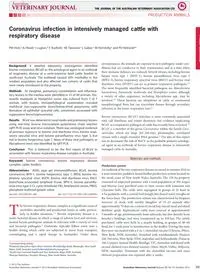
2012 Coronavirus infection in intensively managed cattle with respiratory disease PDF
Preview 2012 Coronavirus infection in intensively managed cattle with respiratory disease
Coronavirus infection in intensively managed cattle with respiratory disease PM Hick,a AJ Read,a I Lugton,b F Busfield,c KE Dawood,a L Gabor,a M Hornitzkya and PD Kirklanda* Background A detailed laboratory investigation identified bovine coronavirus (BCoV) as the aetiological agent in an outbreak of respiratory disease at a semi-intensive beef cattle feedlot in south-east Australia. The outbreak caused 30% morbidity in the resident population and also affected two cohorts of cattle that were newly introduced to the property. Methods At slaughter, pulmonary consolidation and inflamma- tory lesions in the trachea were identified in 15 of 49 animals. Pas- teurella multocida or Histophilus somni was cultured from 3 of 7 animals with lesions. Histopathological examination revealed multifocal non-suppurative bronchointerstitial pneumonia with formation of epithelial syncytial cells, sometimes associated with suppurative bronchopneumonia. Results BCoV was detected in nasal swabs and pulmonary lesions using real-time reverse transcriptase–polymerase chain reaction (qRT-PCR) assay and virus isolation. There was serological evidence of previous exposure to bovine viral diarrhoea virus, bovine respi- ratory syncytial virus and bovine parainfluenza virus type 3, but not to bovine herpesvirus type 1. None of these viral pathogens or Mycoplasma bovis was identified by qRT-PCR. Conclusion This is believed to be the first report of BCoV in association with bovine respiratory disease complex in Australia. Keywords bovine coronavirus; bovine respiratory disease complex; cattle; feedlots Abbreviations AGID, agar gel immunodiffusion; BCoV, bovine coronavirus; BHV-1, bovine herpesvirus type 1; BRSV, bovine res- piratory syncytial virus; BVDV, bovine viral diarrhoea virus; BALT, bronchiole-associated lymphoid tissue; BPIV-3, bovine parainflu- enza virus type 3; Ct, cycle-threshold; FBS, fetal bovine serum; PBGS, phosphate-buffered gelatin saline Aust Vet J 2012;90:381–386 doi: 10.1111/j.1751-0813.2012.00978.x T he bovine respiratory disease complex is a significant cause of morbidity, mortality and production losses in cattle, particu- larly in feedlot situations.1–3 Bovine respiratory disease is a multi-factorial disease in which a range of adverse host and environ- mental factors predispose animals to infection with a variety of viral and bacterial pathogens.4 Outbreaks typically follow entry into a feedlot during which cattle are subjected to stress from transport, commingling and a rapid change in husbandry. Under these circumstances, the animals are exposed to new pathogens under con- ditions that are conducive to their transmission and at a time when their immune defences are reduced. Several viruses, including bovine herpes virus type 1 (BHV-1), bovine parainfluenza virus type 3 (BPIV-3), bovine respiratory syncytial virus (BRSV) and bovine viral diarrhoea virus (BVDV) can act as primary respiratory pathogens.3,5 The most frequently identified bacterial pathogens are Mannheimia haemolytica, Pasteurella multocida and Histophilus somni, although a variety of other organisms, including Mycoplasma spp., may be involved.4,6 These bacteria are ubiquitous in cattle as commensal nasopharyngeal flora, but can exacerbate disease through secondary infection in the lower respiratory tract.6 Bovine coronavirus (BCoV) infection is most commonly associated with calf diarrhoea and winter dysentery, but evidence implicating BCoV as a respiratory pathogen of cattle has recently been reviewed.7,8 BCoV is a member of the genus Coronavirus within the family Coro- naviridae, which are large (65–200 nm), pleomorphic, enveloped viruses with a single-stranded RNA genome.9 The aim of this report was to document the role of BoCV as the probable primary aetiologi- cal agent in an outbreak of bovine respiratory disease in intensively managed cattle in Australia. Materials and methods Production system An outbreak of bovine respiratory disease occurred in autumn 2010 in a semi-intensive,paddock-based feedlot production system located on the south coast of New South Wales, Australia. The 156-ha property consisted of improved pastures with a total population of 300 Angus and Murray Grey purebred cows or their crosses with Limousin and Charolais bulls. The cattle were segregated in groups of 25 head in 4-ha paddocks with a central feed trough, but shared water troughs on the fence lines. The production system was characterised by frequent turnover of stock, with weekly slaughter of 15–25 animals after approximately 70 days on a ration of cereal hay,biscuit meal and dried distillers’ grain. Replacement cattle were sourced at approximately 9 months of age, predominantly from saleyards, but also directly from breeder’s holdings, and were transported up to 450 km. The newly purchased cattle were held in a nearby holding, in groups of 40–60 head, for 1 week prior to introduction to the feedlot. During this time they were vaccinated with a 5-in-1 clostridial vaccine (Ultravac,Pfizer, West Ryde, NSW, Australia), drenched with triclabendazole (Fasinex 240, Novartis,West Ryde, NSW,Australia) and fenbendazole (Panacur 100, Coopers Animal Health, Bendigo,VIC,Australia) and dosed with an oral chelated trace element mixture (Maxi-Min®,Virbac,Milperra, NSW, Australia). Treatment with the clostridial vaccine and trace element preparation was repeated after 4 weeks. *Corresponding author. aElizabeth Macarthur Agriculture Institute, Woodbridge Road, Menangle, New South Wales 2568, Australia;
